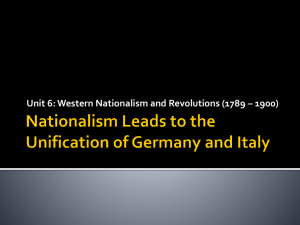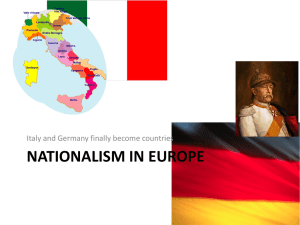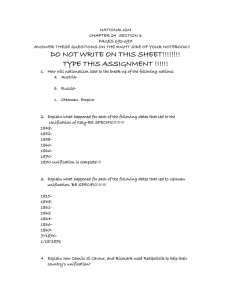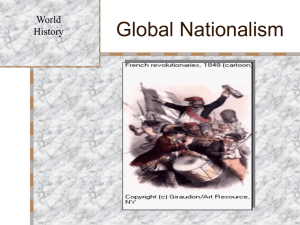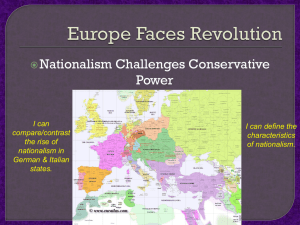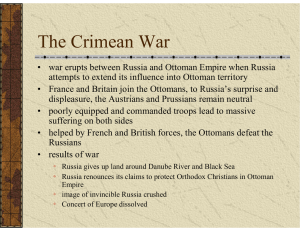Nationalism
advertisement
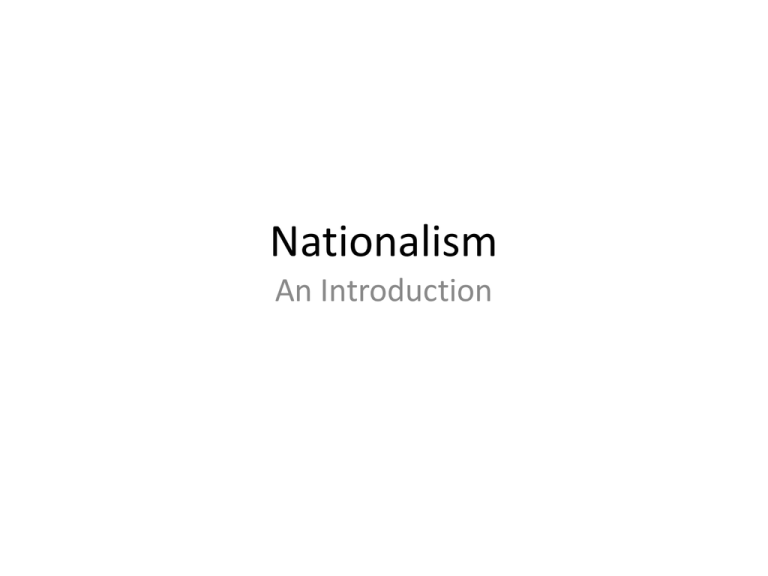
Nationalism An Introduction Thesis The new unification of the working class, coupled with conservative reforms of the Congress of Vienna, led to a new unity within the oppressed classes. This coupled, with the Industrial Revolution caused the lower classes to form an adversarial relationship with the “fat cats” of capitalism. As a way to reclaim power the lower classes rallied around the new idea of the nationstate causing an outburst of Nationalism and eventually resulting the unification of Italy and Germany. Nationalism • Series of “isms” cause shockwaves in European culture and thought • All this leads to a major increase in nationalism, beginning w/ Rev. of 1848 • Most involved major shift to left in political spectrum • Nationalism is the belief that people’s greatest loyalty should not be to a king, but to a nation of people who share common history and culture • Nationalism blurs the lines in political spectrum • Invokes all parts of life: Culture, History, Language, Territory, Nationality, Religion Nation-state • When a nation (a group of people with a common culture or history) has it’s own independent government, it is called a nationstate • You can have nations without states (i.e. no government like Egypt, Libya, Liberia) and states without nations (i.e. no common land like Palestine, Poland 1939, Baltics during cold war) • In 1815, only a few nation-states existed in Europe. – Britain, France, Sweden, Spain, etc. Non nation-states • Germany – Dozens of different kingdoms, principalities, duchies, etc – not united into one nation-state • Italy – 12 different kingdoms – not a nation-state • Austria-Hungary – 9 different languages, 8 kingdoms, 3 religions – not a nation-state • Russia – dozens of different languages, cultures, ethnic groups • Ottoman Empire - 3 continents, 3 religions, many languages • It all starts to change in the mid-1800s Italy • Italians were very interested in the revolutions of 1830 and 1848 • Kingdom of Piedmont-Sardinia (basically western Italy) had a liberal constitution – This appealed to middle class Italians all over the region • Young Italy movement: founded by Giuseppe Mazzini – Took “code names” from the Renaissance and Medieval times – Wanted a democratic, republican form of government – Anti-monarchy Camillo di Cavour Giuseppe Garibaldi Italy • Sardinia’s King appoints Camillo di Cavour as Prime Minister • Goal: gain control over northern Italy • Obstacle: most of northern Italy controlled by Austrian Empire • Tactic: get Napoleon III of France to help drive the Austrians out – And it worked Southern Italy • Meanwhile, Cavour was secretly aiding rebels in the south of Italy • Giuseppe Garibaldi leads nationalist rebels and takes over Sicily • Red Shirts: Followers all wore red shirts, they become known by that name • Garibaldi and his troops march north, Cavour has his king meet Garibaldi in Naples, they unite the south to Sardinia • Garibaldi steps aside and lets the king rule over both parts in 1860 King Victor Emmanuel II Venice, Rome and the Pope • Two areas remain “outside” • Austrian province of Venetia – Where Venice is located - joins Italy in 1866 • Papal States – Conquered by Garibaldi’s forces – Directly controlled by the church – Including the city of Rome • Now all of Italy is united and controlled by one government – except for the Vatican City which remains the Pope’s own kingdom Italian unification ● Creation of the German Confederation under the presidency of Austria. Prussia and Austria were the two most powerful German states. Traditionally Austria was recognized as the most important. There was a strong popular movement for unification but neither Austria nor Prussia was prepared to allow it happen. Germany: 1815 Otto Von Bismarck: “The Iron Chancellor” 1815-1898 Realpolitik • Realistic politics based on the needs of the state – Whatever actions necessary to achieve his desired goals. • Power more important than principles • “Blood and Iron” Philosophy – He wanted to eliminate Austrian influence and bring about unification on Prussian terms. – Expand Germany’s economic and industrial base with use of its resources. – Do not make the same mistakes that were made by the French in 1848-1849 (chaos and indecision) 3 Wars for Unification • • • 1st: An Austrian-Prussian invasion of Schleswig-Holstein led to the end of Danish control of these provinces. Prussia gained a lot of support especially among German nationalists who wanted to see these provinces come under German control. 2nd: Austro-Prussian War results in Prussian control of several northern German states. – Dissolved the old confederation and establishes a new one dominated by Prussia – Southern states were left independent, form military alliances with Prussia 3rd: Franco-Prussian War results in the completion of German Unification – Wilhelm I of Prussia assumes the role of Kaiser, or emperor of Germany, with Otto von Bismarck as Chancellor. Germany 1871 ● The new German Empire emerged as Europe’s foremost military power. Prussia dominated this new German state. Other nationalist movements • Ireland tries to break with UK after the famine (and then tries again, and again, and again)— leads to Rebellion, Civil War, IRA, etc. • Balkans (most notably Serbia) try to break with Ottoman Empire and/or Austria Hungary—forming something called Greater Serbia (lots more on this later) which is still and issue today • France tries to rally against “foreign” issues and united in Anti-Semitism, Dreyfus Affair • Russia has to deal with autocrats ruling a huge, decaying empire Types of Nationalist Movements • Unification – Mergers of politically divided but culturally similar lands • 19th century Germany • 19th century Italy • Separation – Culturally distant group resists being added to a state or tries to break away • Balkans in the Ottoman Empire • French-Canadians in Canada • Ireland • State-building – Culturally distinct groups form into a new state by accepting a single culture • The United States • Turkey • USSR New face of Europe • Britain and Germany now the most powerful nations in Europe • France defeated, but still fairly strong • Austria and Russia lagged far behind, and were falling apart • Seeds are sown for the biggest conflict • Next: Britain, France, colonialism in Africa – all leading up to World War I
